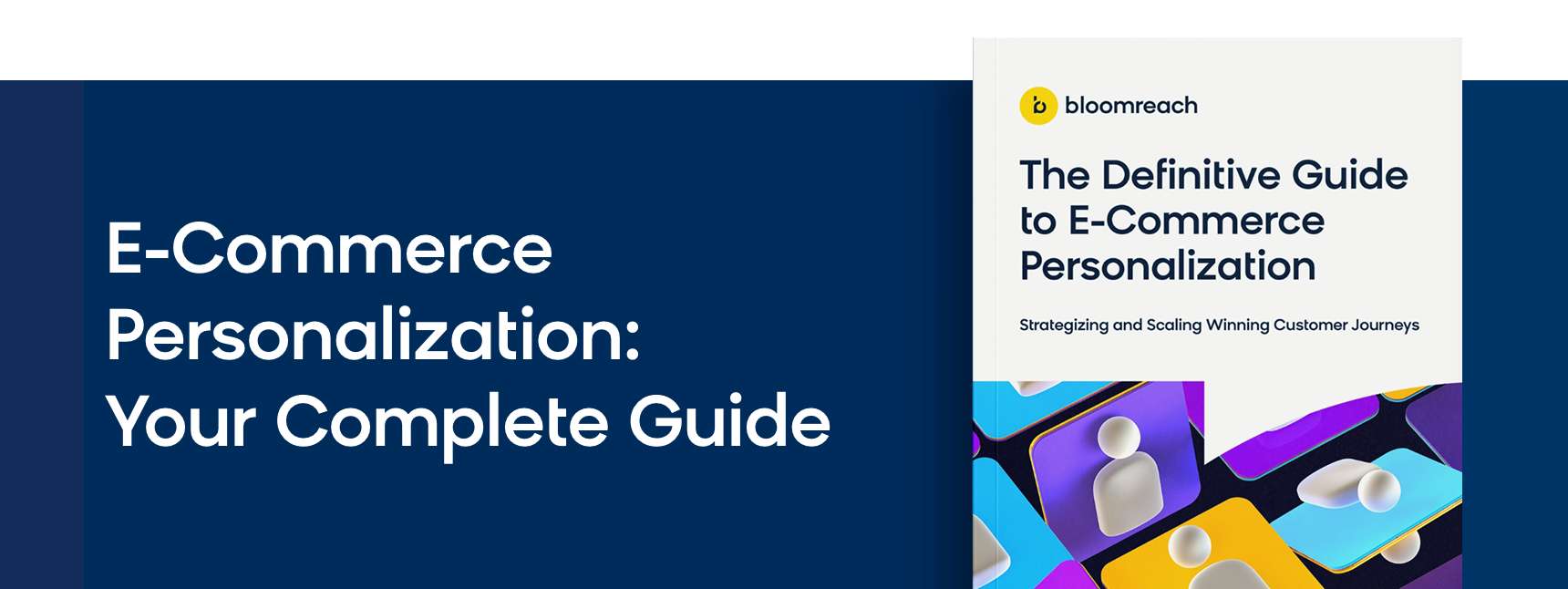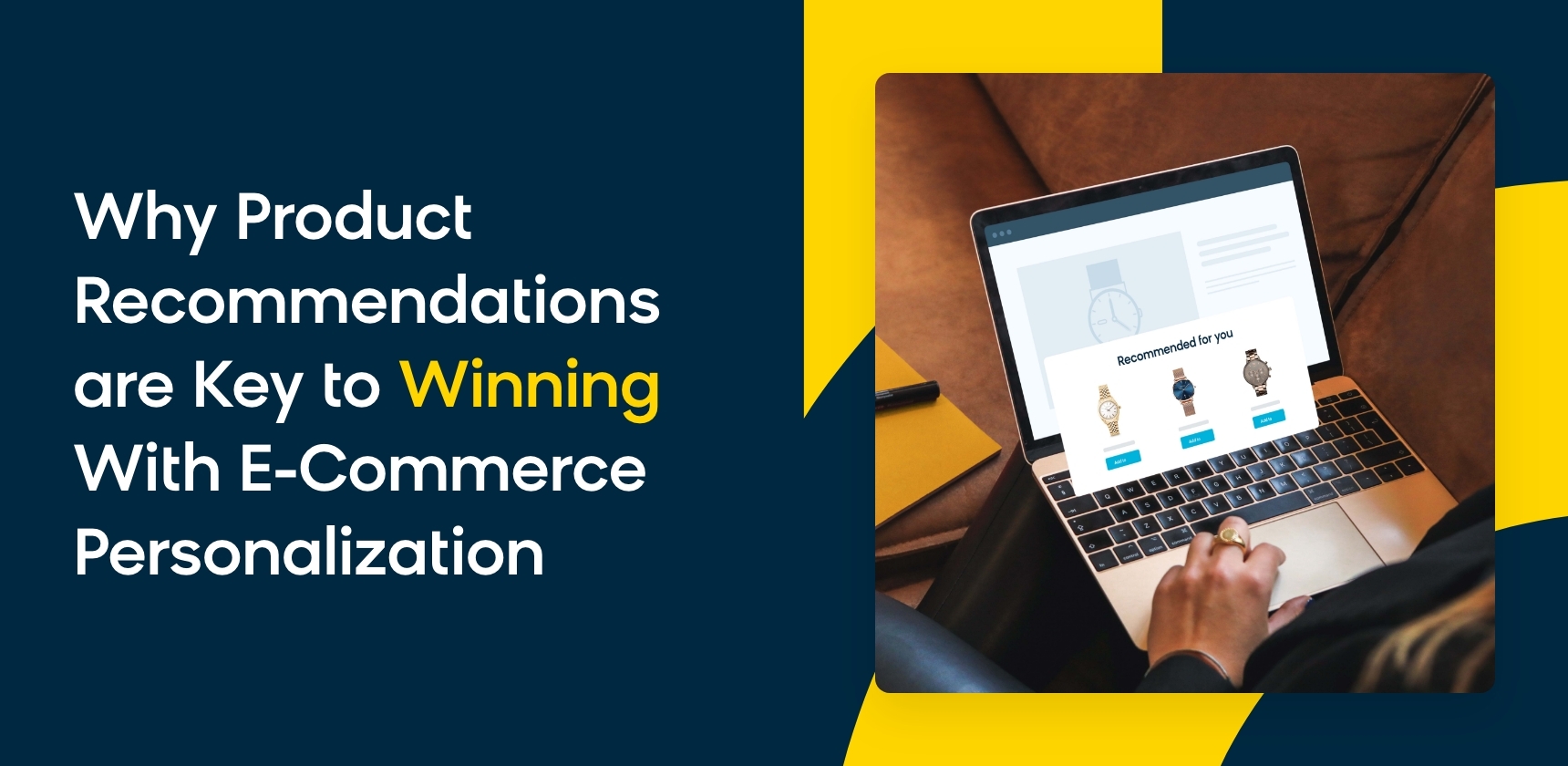What Is a Customer Data Platform (CDP) and the Benefits of It? The Definitive Guide
By Jordan Torpy
10/27/2023

You’ve heard the buzz about customer data platforms. You’ve heard the letters CDP bandied about. Maybe your boss asked you if your company needs a CDP. Maybe you’re a boss wondering the same thing.
Whatever questions you have about CDPs, you've come to the right place. We’re here to give you all the info you need on this crucial marketing technology.
- A CDP is a smart, user-friendly software that confidently consolidates and manages all customer data, creating a unified, enduring record of each customer's attributes.
- Unlike some other database software programs, a CDP is a tool built mainly for marketers. But having access to technical support will be essential for integration and operation concerns.
- While a CDP is similar to customer relationship management (CRM) software, it is also distinctly different and a CDP with marketing automation capabilities gives marketers additional options to power ecommerce personalization.
What Is a Customer Data Platform (CDP)?
A Customer Data Platform (CDP) is a type of marketing technology software. Specifically, it’s a kind of unified customer database software: one that creates persistent, consolidated records of all your customers, their attributes, and their data. A good CDP should easily integrate with your existing data and allow for easy retrieval of the data it stores.
A CDP builds a complete picture of your customers on an individual level. It collects first-party customer data (transactional, demographic, and behavioral data) from a multitude of sources and systems, and links that information to the customer that created it.
This creates a 360-degree customer profile, also called a single customer view, which can then be used by third-party tools or built-in marketing automation tools to execute marketing campaigns and analyze their performance.
How to Build a Customer Data Platform
So, how do you build a CDP? For any customer data platform to function, there are three main steps involved:
Integration
First and foremost, compiling and assembling all relevant data into a single database is the primary task of any CDP. It works to solve the problem of disconnected data sets by linking all your sources and systems together in one place.
Organization
Once your data is integrated, a CDP needs quality control protocols. It needs to identify and address any missing information, remove duplicate data sets, and cross-check for accuracy so that segments and audiences can be identified.
Identity Resolution
After connecting all the dots, merging data from multiple sources and attributing it to specific customer profiles is where a customer data platform really shines. This is called data unification and it lets you build complete profiles of every individual customer, where you can build and expand on insights as they interact with your business.
What are the Values and CDP Characteristics
There are a variety of businesses offering various CDP offerings, but the best of the best provide a few essential characteristics that every marketer should look for:
- Ready‑to‑Use Solution
All customer data is neatly organized and available for immediate use. Some technical resources are required to set up and maintain the CDP, but it does not require a high level of technical skill compared to a traditional data warehouse.
- Single Customer View
Customer data collected and organized with a CDP is visualized through individual data profiles for each user. This 360-degree view of the customer is possible due to the fact that all customer data is located in one central location.
- Customer Data Unification
Inconsistent data from multiple online and offline sources is combined to create a unified single customer view.
- Accessible Data for Third Parties
Data contained within a CDP is ready for use in third-party systems focused on adtech and campaign delivery.
Who Needs a CDP
Unlike some other database software programs, a CDP is a tool built mainly for marketers. That doesn’t necessarily mean that a CDP can be operated without any technical support. To get the most out of a CDP, an organization will typically need these three roles:
- Marketer: a person who understands the market and can suggest business-tailored use cases for the CDP.
- IT Person: someone to help support the marketer during the implementation phase of the CDP, and can help manage tasks like using webhooks, deploying recommendations on the web, or helping with integrations. Knowledge of HTML, CSS, and Javascript is also helpful for building powerful weblayers.
- Analytical Person: someone that knows how to work with data and what to track in custom dashboards, how to analyze A/B tests, and can report results to the marketing team.
These don’t have to be three separate people, but for maximum value from a CDP you’ll need all those skills.

What Is the History of Customer Data Platforms?
Managing customer data is nothing new. From handwritten filing cards and massive independent mainframes to modern cloud-based solutions, the search for the best tool has been going strong for decades. Modern computing power has significantly increased the pace of progress, allowing for more and more useful tools.
Online customer relationship management (CRM) software was introduced in the 90s and allowed companies to manage their interactions with both current and potential customers. These customer relationship management platforms could also perform customer data analysis that could help drive retention and sales. While useful, these tools had some limitations: They only managed data for registered clients and only used predefined first-party data.
Things changed in the 2000s with the rise of data management platforms (DMPs). These were aimed towards advertisers and helped with the planning and execution of media campaigns. Unlike CRMs, DMPs worked with second- and third-party data, and could segment anonymous IDs.
The customer data platform (CDP) was introduced a few years back as a reaction to the demand for an improved customer experience and omnichannel marketing initiatives. Older tools, while useful for their purposes, had created data silos. CRM data was one thing, DMP data was another — and marketers weren’t able to productively use all the data they had access to.
CDPs solved this problem by offering a unified customer view that gathers a company’s first-party data (and to some extent, second- and third-party data) into a single, comprehensive platform. A major advantage of CDPs is their ability to store extremely granular first-party data, such as events on a website.
Bloomreach Engagement: A CDP Since 2012
Bloomreach acquired Exponea in early 2021, a SaaS company that built its CDP architecture from the ground up starting in 2012. This has allowed Bloomreach to refine and improve its customer data platform, and build powerful tools on top of it to help modern businesses manage customer data and harness its utmost potential.
Thanks to years of hard work and growth, Bloomreach has an industry-leading CDP, made even more powerful by user-centric analytics, predictions, recommendations, and marketing automation layers. We call it Bloomreach Engagement.
Why Is Customer Data Important?
Today’s customers expect a lot from companies. They’ve experienced good personalized service, and if you want to keep their business, you need to provide that elevated standard. A consistent customer experience across channels, appropriate recommendations, tailored communications — for today’s customers, these are necessary.

Not many companies can actually deliver these personalized experiences. But if you can’t meet customers heightened expectations, you have a problem. If customers think you don’t care about them, they’ll take their business somewhere else — and they won’t be coming back. The fight to win those customers back will be much more difficult than getting their business in the first place.
This is why it’s so crucial to have well-maintained, accessible, and insightful customer data. And now, a good CDP makes that possible. It’s only a matter of getting the right data.
What Kind of Customer Data Does a CDP Work With?
The sheer volume and speed of digital data is hard to comprehend, and overwhelms traditional database software. A CDP, however, is purpose-built to manage this flow of data.
The most reliable way for a CDP to collect this type of data is via their own SDK, but most CDPs can also ingest data from other systems via JSON or batch ETL transfers.
The types of data a CDP can work with include:
- Events: behavioral data that arises from a user’s actions in a session on a website, in an app, or on a mobile browser.
- Customer Attributes: this includes names, addresses, contact details, birthdays, etc. Advanced CDPs can also store machine learning-powered predictions, such as likelihood to purchase.
- Transactional Data: purchases, returns, and other info from ecommerce or POS systems.
- Campaign Metrics: engagement, reach, impressions, and other metrics from campaigns.
- Customer Service Data: live chat data, number and length of interactions, frequency, NPS scores, and other data from CRM systems.
What Makes Customer Data Platforms Different From DMP and CRM?
When comparing data gathering software, it’s easy to get overwhelmed. There’s a sea of similar acronyms, product descriptions that look almost the same, and lots of claims about which program best suits your needs.
You might have come across customer relationship software (CRM), CDPs, and data management platforms (DMP). While their capabilities might sound similar, it’s important to understand the distinctions between them so you can evaluate vendors and choose the right product for your business needs.
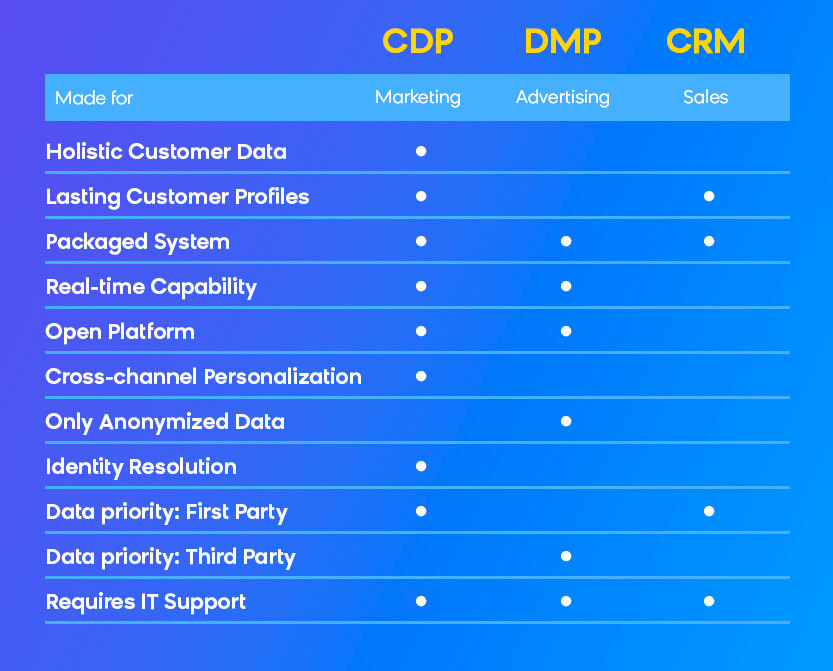
CDP vs. DMP vs. CRM: Table Explained
- Holistic Customer Data: Does the platform manage customer data from all available sources (behavioral, demographic, personal, transactional, device, etc.)?
- Lasting Customer Profiles: Does the platform retain data for a long period of time?
- Packaged System: Can the platform exist as a ready-to-use piece of software?
- Real-time Capability: Does the platform update data in real time, allowing for quick reactions to changes?
- Open Platform: Is it simple to get data into the platform? Is it easy to share data from the platform with other services?
- Cross-channel Personalization: Does the platform allow for the personalization of messages across different customer touchpoints?
- Only Anonymized Data: A data management platform by design works with anonymized customer data. CRMs and CDPs work with identified customers, and allow for granular views of individual customers.
- Identity Resolution: Does the platform allow you to connect the customer behavior of anonymous visitors with known customers after they have given their consent? Does the platform recognize customers across devices?
- First-party Data Priority: Does the platform primarily deal with data from first-party sources?
- Third-party Data Priority: Does the platform primarily deal with data from third-party sources?
- Requires IT Support: Does day-to-day operation of the software require support from IT?
Finding the right platform is no easy task. But understanding what you can expect your CDP to do for you on a daily basis helps.
In our knowledge card, you’ll get essential know-how on CDPs and learn more about the features that your company should be looking for in its CDP.
Types of Customer Data Platforms
The customer data platform market has matured, leading to a number of different providers. These providers are differentiated based on their target market and their intended use cases. Let’s take a look at some of the differences.
A Standalone CDP vs. CDP + Marketing Automation
A key distinction among CDP vendors is whether they provide a product which is only a CDP, or a CDP plus other capabilities. It’s crucial to understand what your vendor is providing, because this distinction can cause large differences in how your business uses the CDP.
A Standalone CDP
A standalone CDP is exactly what it sounds like: a customer data platform without extra capabilities. It ingests all of a company’s first-party data and builds complete pictures of all of your customers (a single customer view). Usually, a standalone CDP will offer analytics capabilities, allowing for granular segmentations of your audience.
This data is accessible for use by other systems, but the standalone CDP cannot execute campaigns. It needs dedicated tools that can make use of the comprehensive data it collects.
For companies that already have campaign execution tools, a standalone CDP might make sense. But companies that lack those capabilities should consider a CDP + marketing automation platform.
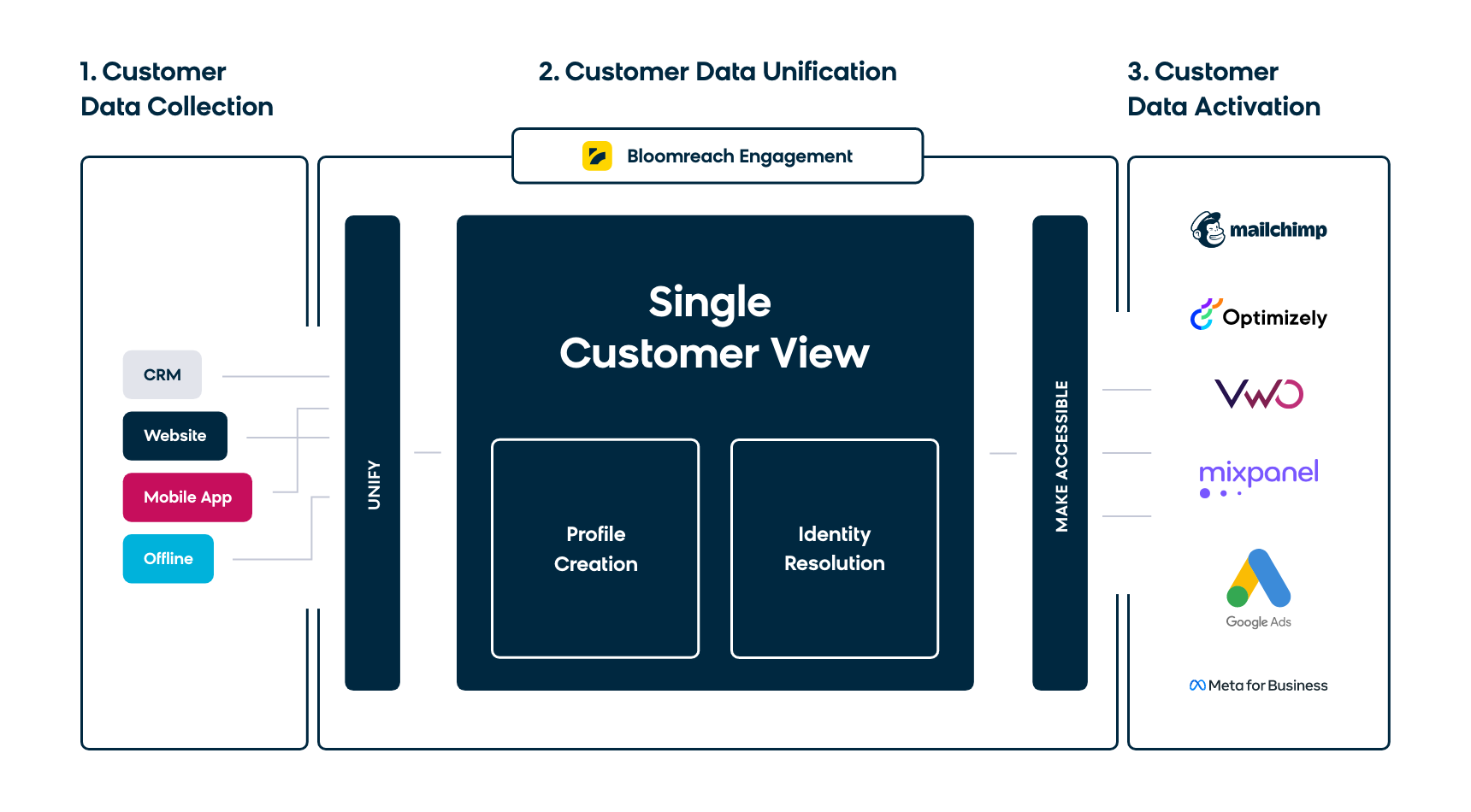
CDP + Marketing Automation
A customer data platform coupled with marketing automation is the next generation of the CDP. It combines all the benefits of a standalone CDP with marketing campaign tools, creating a single, powerful, customer-centric marketing platform.
This gives marketers the complete toolset they need for creating incredible customer experiences by bringing together AI-driven marketing capabilities, real-time analytics, and UX optimization with a CDP.
A CDP combined with marketing automation simplifies workflows and increases productivity by collecting frequently used tools into one integrated interface. But it is also flexible and can fit into your existing tech stack — it molds around what you already have and fills gaps.
Key Benefits:
- Provides a foundation for a 360-degree customer view
- Makes customer loyalty-driven decision making possible
- Facilitates more precise targeting and higher-quality interactions with customers
- Allows for meaningful analysis of marketing initiatives across different channels
- Enables agile responses to changes in the market or customer preferences
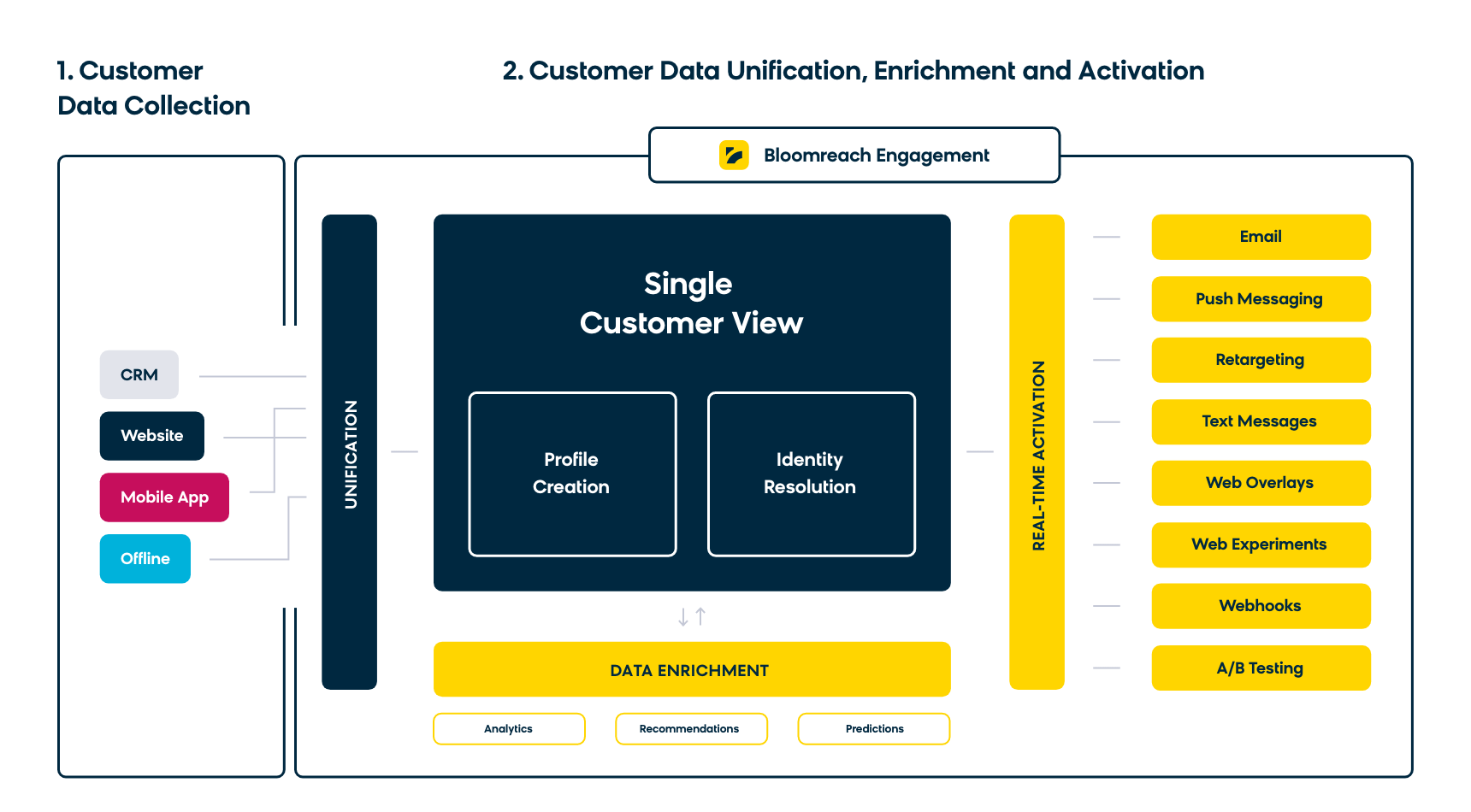
Bloomreach Engagement: The Most Versatile Platform on the Market
Bloomreach offers you the flexibility to pick and choose which features you want to use; it’s not an “all-or-nothing” solution. Although Bloomreach is a CDP + marketing automation, it can act as a standalone CDP to provide a unified source of customer data to an existing technology stack, or it can be used to handle all marketing activities using the additional layers of campaign execution and analytics.
If you already have a CDP, Bloomreach Engagement’s customer data engine can help you fully activate your data and maximize the ROI of your ecommerce marketing efforts. Our customer data engine is what makes our platform truly stand out with capabilities that go beyond the standard scope of marketing toolsets. Our powerful data core combines CDP capabilities and advanced analytics to help marketers understand the customer journey in real time and create omnichannel campaigns that drive results.
The Difference Between Enterprise-grade CDPs and Small Business CDPs
There are multiple CDP providers out there, each with differing purposes and capabilities.
A key consideration when choosing a CDP is the intended scale of the software. Is it built for small businesses? Or is it a full-fledged enterprise solution? There are some key points to remember when answering these questions:
Scalability. Enterprise-level companies need to work with massive amounts of data. That data can change quickly, and for a CDP to be useful, it needs to respond to those changes swiftly and accurately. This means that CDP architecture needs to be built for scale from the very beginning.
Flexibility. No two companies are the same. For enterprise-level companies, a plug-and-play solution will almost never be suitable for the unique needs of a company — therefore flexibility in a CDP is a must-have. A customer data platform must be able to ingest a company’s data from all its unique sources, as well as interface successfully with the platforms the company uses to function.
Integrity. A CDP needs to be trusted with the sensitive data it uses, and that can mean data for millions of customers. This requires rigorous security protocols and a dedication to privacy. These need to be core values of the CDP provider if they are to be trusted with customer data.
Bloomreach Engagement: An Enterprise-grade CDP
Bloomreach Engagement was built from the ground up as an enterprise-grade CDP. Thoughtful product planning and experience with world-class clients has made Bloomreach an industry leader in customer data platforms for the most demanding of applications.
Scalability: Bloomreach’s agile in-memory framework is scalable by design and is ready to handle massive volumes of rapidly changing data at the speeds necessary for business success.
Flexibility: Bloomreach easily adapts to the needs of enterprise-class businesses. A quick onboarding process integrates Bloomreach with existing data. A rich API makes third-party integrations smooth and painless. And native integrations with best-in-class tools means Bloomreach works with the tools you already use.
Security: Privacy and security have been core values of Bloomreach from the very beginning. Bloomreach undergoes regular audits to maintain our status as a leader in this area.
The Benefits of a Customer Data Platform (Key CDP Use Cases)
There's a mutlitude of benefits to using a CDP, but most the types of advantages you get from a platform really boils down to the way your business wants to employ it.
And just as there are numerous benefits, there is the large number of CDP vendors on the market, which can be overwhelming. When choosing a vendor, it's helpful to consider the use cases you hope to accomplish with a help of CDP.
While it’s important to have high-level goals (improve the customer experience, foster loyalty, etc.), you also need to know how a CDP can help you achieve those goals through lower-level use cases.
We’ve collected what we believe to be some of the most important use cases, and benefits, below.
CDP Use Cases:
1. Online to Offline Connection
Merge online and offline activities to create an accurate customer profile. Identify customers from online activities when they enter a brick and mortar store.
2. Customer Segmentation and Personalization
Segment customers according to their behavior (RFM, LTV prediction) to deliver a personalized, omnichannel experience throughout the entire customer lifecycle.
Read This Next: Ecommerce Personalization: Your Complete Guide
3. Predictive Customer Scoring
Enrich your customer profiles with predictive data (probability of purchase, churn, visit, email open rates).
4. Smart Behavioral Retargeting and Lookalike Advertising
Integration with Facebook Ads, Google Ads, Google Analytics, and Doubleclick enables you to leverage insights and run powerful acquisition and retention (lookalike) campaigns outside of your website.
Read This Next: Weird Fish Increases Facebook Ads Revenue by 82% With Bloomreach
5. Product Recommendations
Create different recommendation models such as “similar products” or “customers also bought” and deliver the best shopping experience to drive engagement, increase brand loyalty, and sell, up-sell, or cross-sell your products or services.
Read This Next: Why Product Recommendations Are Key to Winning With Ecommerce
6. Conversion Rate Optimization and A/B Testing
Quickly transform the appearance of your pages. Use our smart website overlays (pop-ups) or send cart abandonment emails to increase your ROI. Create different designs and determine which variant performs better with the automatic A/B testing feature.
7. Omnichannel Automation
Guide your customers through their entire lifecycle with personalized messages sent to their preferred channel, significantly enhancing your opportunities to both acquire and keep a loyal customer.
Read This Next: What Is Omnichannel Commerce? Definition, Benefits, and Trends
8. Email Deliverability Enhancement
Increase email open rates. Thanks to an AI-powered algorithm, you can determine the ideal distribution time for each user based on their email opening habits and reach them at this optimal hour.
9. Reviews Optimization
Get better and more frequent online reviews from your customers through personalized omnichannel communication and NPS survey analysis.
How Can a CDP Improve Customer Lifetime Value and Foster Customer Loyalty?
The most effective way to foster customer loyalty is to give your customers exactly what they’re looking for: a consistent, high-quality, and personalized experience. Customer data platforms make it possible to deliver these experiences at scale, personalizing the journey of each customer.
CDPs enable loyalty-building strategies by solving the problem of fragmented data silos. They arrange customer data in a way that makes personalization at scale possible (though personalization tools themselves are not always part of a CDP).
If your data is siloed, you can’t create a consistent experience for your customers. Without that central data hub, you can’t provide the omnichannel experience customers expect, which is receiving up-to-date interactions regardless of which channel the customer communicates through.
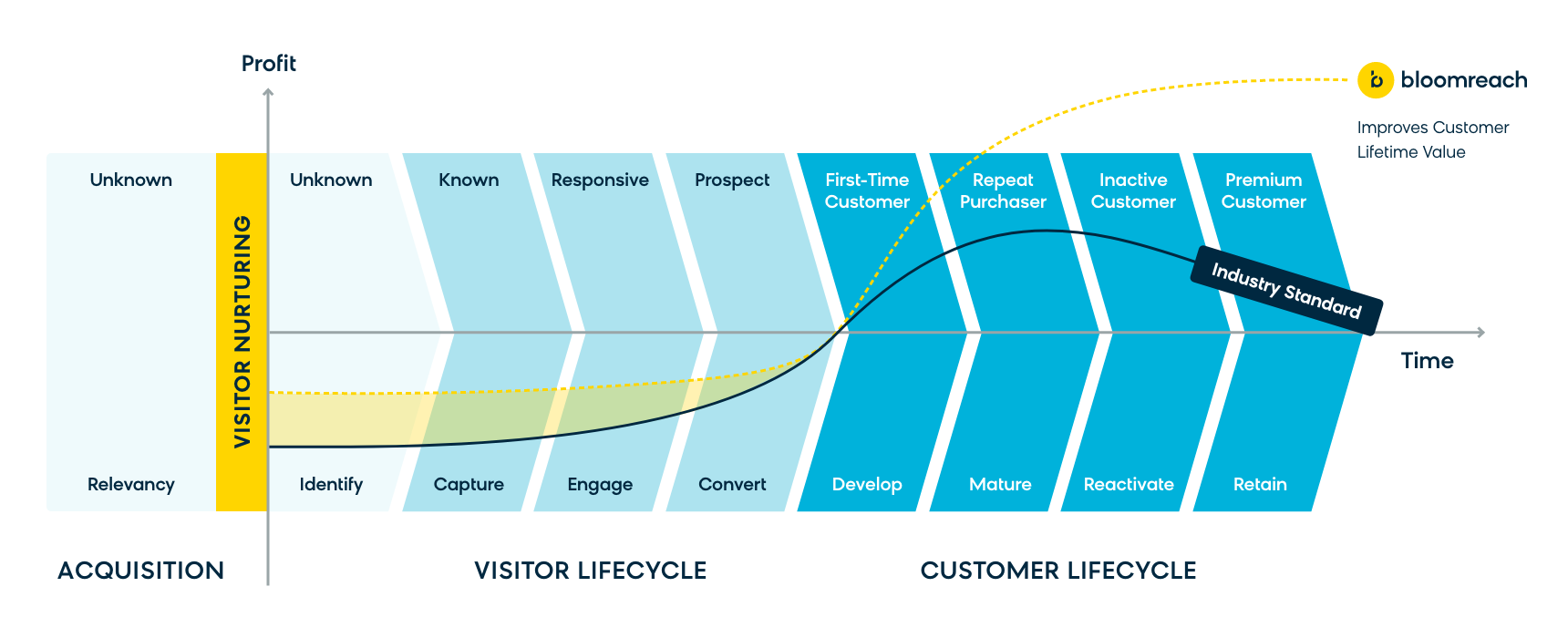
Read This Next: 3 CDP Personalization Tactics to Fuel Your Marketing
How Long Does It Take to Implement a Customer Data Platform?
The short answer? It depends. A very rough estimate would be 4-12 weeks.
The long answer? Without knowing the details of your organization and business needs, there’s no one-size-fits-all answer. There are a few things you’ll need to take into consideration:
- Integration complexity — how many tools will you need to integrate with?
- CDP output requirements — what will you need from the CDP?
- Current state of your data — data cleansing can lead to a longer implementation
- Unique business rules — are there business-specific stipulations to consider?
- Identity merging needs — siloed data can lead to a single customer having multiple profiles across different platforms, and merging these profiles takes time
- Level of detail in data attributes
Every business that wants the benefits of a CDP will have different requirements and goals, making it impossible to give a precise answer to how long the implementation process will take.
Nevertheless, most businesses can expect to go through a similar set of steps when implementing a CDP.
Let’s walk through the typical steps in the process of implementing a CDP.
We’ll also look at the differences between implementing a standalone CDP and CDP with built-in campaign execution and analytics capabilities.
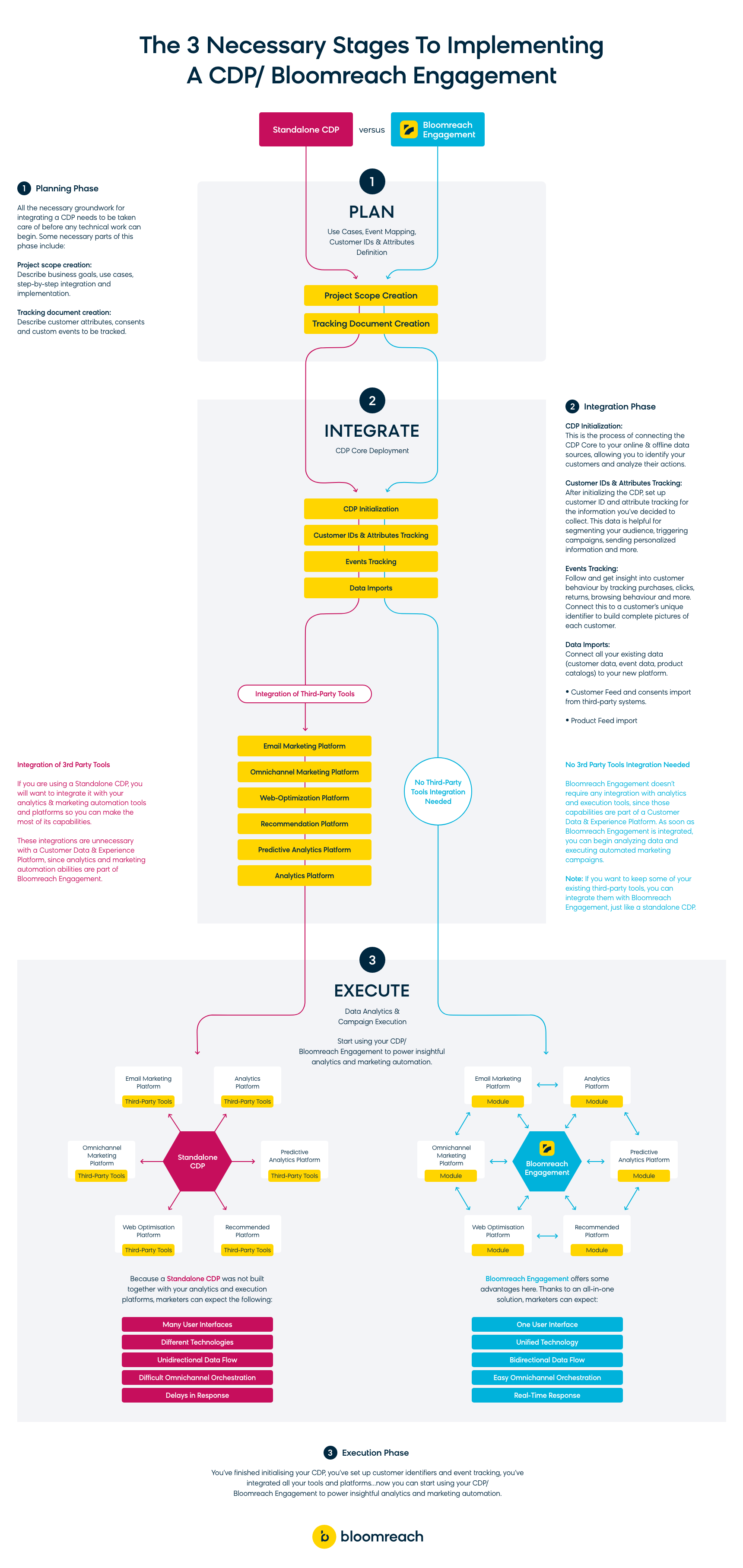
The 3 Necessary Stages To Implementing a CDP
1. Planning Phase
All the necessary groundwork for integrating a CDP needs to be taken care of before any technical work can begin. Some necessary parts of this stage include:
Project Scope Creation: describe business goals, use cases, step-by-step integration and implementation.
Tracking Document Creation: describe customer attributes, consents, and custom events to be tracked.
2. Integration Phase
Once ouy lay the groundwork, it's time for the technical integrations to begin. Most of the integration steps will be standard for any data collection tool, but this process will vary slightly depending on what type of CDP you choose. Let's go over the routine integration steps first:
CDP Initialization: This is the process of connecting the CDP to your online & offline data sources, allowing you to identify your customers and analyze their actions. With Bloomreach, this is very simple: just paste a snippet of code into the header of your website. Other solutions might look quite different.
Customer IDs and Attributes Tracking: After initializing the CDP, set up customer IDs and attributes tracking for the information you’ve decided to collect. This data is helpful for segmenting your audience, triggering campaigns, sending personalized information, and more.
Events Tracking: Follow and get insight into customer behavior by tracking purchases, clicks, returns, browsing behavior, and more. Connect this to a customer’s unique identifier to build complete pictures of each customer.
Data Imports: Connect all your existing data (customer data, event data, product catalogs) to your new platform.
The steps in this importing process depend entirely on your CDP.
If you are using a Standalone CDP, you will want to integrate it with your other tools and platforms so you can make the most of its capabilities. Consider which of the below platforms you want to use. They will each need to be integrated with the CDP.
- ESP Integration
- Business Intelligence Platform
- Web Optimization Platform
- Recommendation Platform
- Predictive Analytics Platform
- Advertising Platform
- Mobile Marketing Platform
These integrations are unnecessary with a CDP + marketing automation, since analytics and automation abilities are built in.
If you are using a CDP + Marketing Automation, there's no further integration process needed. A CDP + marketing automation platform doesn't require any integration with analytics and execution tools, since those capabilities are native. As soon as the platform is integrated, you can begin analyzing data and executing automated marketing campaigns.
Note: If you want to keep some of your existing third-party tools, you can integrate them with Bloomreach Engagement, just like a standalone CDP.
3. Execution Phase
You’ve finished initializing your CDP, you’ve set up customer identifiers and event tracking, you’ve integrated all your tools and platforms — now you can start using your platform to power insightful analytics and marketing automation.
But again, this process will look different depending on what type of CDP you employ.
Because a standalone CDP was not built together with your analytics and execution platforms, you can expect the following:
- Many User Interfaces
- Different Technologies
- Unidirectional Data Flow
- Difficult Omnichannel Orchestration
- Delays in Response
A CDP + marketing automation offers some advantages for execution. Thanks to an all-in-one solution, marketers can expect:
- One User Interface
- Unified Technology
- Bidirectional Data Flow
- Easy Omnichannel Orchestration
- Real-time Response
How to Choose the Right CDP for Your Company
After you’ve decided that a CDP is the right tool for your business, you’ve got to decide which vendor to choose. The number of possible vendors might make the choice seem overwhelming, so it’s important to have a plan for your buying process.
Each company will have different requirements and use cases, but some parts of the buying process should look the same for most businesses.
First, you need to define your use cases. How do you plan to use a CDP? Do you want a CDP with execution layers and ecommerce personalization capabilities? Or do you just need identity resolution and customer segmentation (standalone CDP)? Answering this question will help you better understand your requirements.
Once you’ve done that, you can start to match your requirements to potential vendors. Can they handle the use cases that you require? This allows you to create a short list of candidates.
Next, evaluate the vendors you’ve selected. Ask them to demonstrate their platform executing a use case that you require, instead of relying on a canned demo that only showcases the best that platform has to offer. This will show you if a potential solution is right for you or not.
Finally you can make your decision. This might involve an RFP or a pilot project to make sure that the solution you’ve chosen actually meets your needs. If it has, congratulations! You’re ready to start taking advantage of all a CDP has to offer.
Why Choose Bloomreach Engagement?
While other companies have recently decided to jump on the CDP bandwagon, Bloomreach offers a CDP + marketing automation solution that has been in existence since 2012. Our Engagement platform is entirely homegrown — all parts of the platform were built to work together, which means faster integrations, smooth operation, and better results.
Bloomreach Engagement is scalable, flexible, and secure. Companies from around the world have opted in for Bloomreach to unify their customer data and power their customer experiences. This includes Sofology, Yves Rocher, BrewDog, and so many more.
To learn more about how Bloomreach Engagement can help your company, schedule a personalized demo today.
Found this useful? Subscribe to our newsletter or share it.



